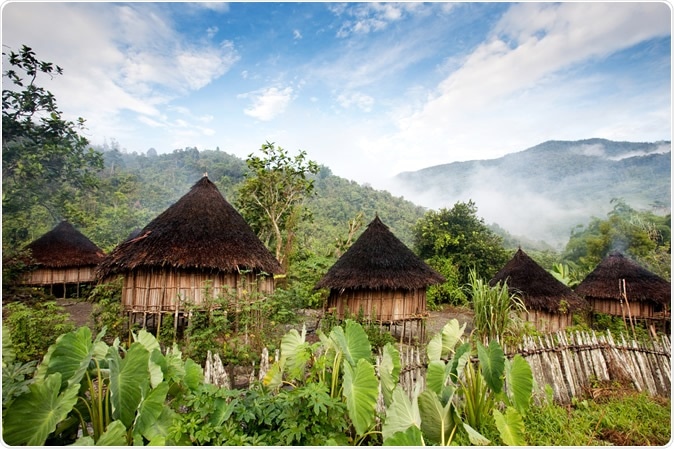COVID-19 only kills 1% of people in remote Papuan village with limited resources
by Sally Robertson, B.Sc.A researcher from Vrije Universiteit Amsterdam, The Netherlands, and a tropical medicine expert who lives in Wamena, Indonesia have published a unique account of a village in the Papuan highlands of Indonesia that has experienced what was presumed to be an outbreak of coronavirus disease 2019 (COVID-19)
The report describes the outbreak pattern of suspected severe acute respiratory syndrome coronavirus 2 (SARS-CoV-2) as it spread across the entire village over the course of five weeks.
A key finding of the study was that the overall death rate was only 1%, despite limited healthcare provision and a lack of mitigating measures.
The authors say the low death rate be attributable to the young age of the village’s population, which is an average of just 21.7 years, and that this may also be the case in similarly remote areas.
A pre-print version of the paper can be accessed in the server medRxiv* while the article undergoes peer review.
The challenges facing low- and middle-resource countries
Although the COVID-19 pandemic presents a significant challenge to all countries, low- and middle-resource countries face even greater difficulties due to their often limited resources and lack of medical facilities, even under normal circumstances.
Now, Elco van Burg and colleague Wijnanda van Burg-Verhage have described the spread of what was presumed to be COVID-19 across a remote Papuan highlands village, referred to here as M20 for patient data protection purposes.
About the village
At an altitude of 6,700 feet, this isolated village is served only by small aircraft or people walking in from nearby villages. Around half of the population is aged under 12 years. The rest is comprised of four to six matriarchs, young adults, and adults aged 30 to 50 years. The nearest health facility takes about three hours to walk to, but no trained healthcare workers are usually present.

Study: Eruption of COVID-19 like illness in a remote village in Papua (Indonesia). Image Credit: Tyler Olson / Shutterstock
Instead, a daily basic medical health service is provided by lay healthcare workers. The current report was based on patient care records kept by these health workers before and after the outbreak and on the input of medical doctors who replied to online requests for help.
The researchers report that between 20th February and 31st March, the dense social structure of the village meant the rapidly spreading outbreak affected almost all (90 to 95%) of the 200 people estimated to be living in the village.
Timeline of disease spread
The first patient presenting with what was suspected to be COVID-19 sought care on 20th February. The researchers say this patient may have been the first to infect the village since he had visited a nearby area where similar symptoms had been reported.
Two weeks later, many villagers experienced a sore throat and stomach complaints, followed by fever and fatigue lasting up to five days.
Severe fever (above 40 °C), shortness of breath, and chest pain generally started after day five of illness.
Two men, aged over 40 years, who had an underlying chronic illness that was thought to be kidney-related, died on the 9th March, following two days of extreme shortness of breath.
The healthcare workers treated symptomatic people with paracetamol up to four times daily; measured temperatures daily and administered antibiotics and chloroquine to patients who seemed “very sick.”
What were the outcomes?
Overall, the healthcare workers treated 101 patients (approximately half the village).
Aside from the two men who died, all patients either recovered or were recovering at the time of the study.
Informal questioning across the population revealed that only about ten villagers did not report symptoms, giving a presumptive infection rate of 90 to 95%.
Twelve patients were aged older than 40 years, and aside from the two who died, another five were “very sick,” meaning 41% of this age group suffered a severe illness, and 17% died. The authors say this is roughly consistent with other reports.
The effect of age distribution
The overall death rate was only 1%, report the researchers, despite the lack of health facilities and mitigating measures.
“This age distribution, common in Papuan highland villages, may reduce case fatality rate (CFR) in similarly remote areas since survival to old age is already very limited, and CFR among younger people is lower,” concludes the team.“The relatively young population, with a majority of women, probably influenced the impact of the epidemic, resulting in only two deaths so far,” they write.
*Important Notice
medRxiv publishes preliminary scientific reports that are not peer-reviewed and, therefore, should not be regarded as conclusive, guide clinical practice/health-related behavior, or treated as established information.
Journal reference:
- Burg E and van Burg-Verhage W. Eruption of COVID-19 like illness in a remote village in Papua (Indonesia). bioRxiv 2020. doi: https://doi.org/10.1101/2020.05.19.20106740